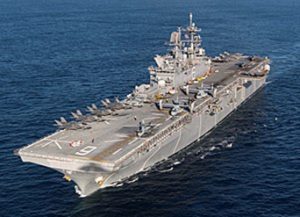Commentary
Recent Commentary
Hong Kong Yearning to Protect Its Freedoms
Freedom loving people everywhere owe a large debt of gratitude to the brave citizens of Hong Kong who last April began a series of peaceful demonstrations initially demanding freedom from extradition of suspects to be handed over for trial in courts in Mainland China. The new law proposed by the city government under Chief Executive Carrie Lam was in contradiction to the rights set forth in the treaty of 1997 by which the British Colony would become a part of China in fifty years.
Apparently Chinese President Xi Jinping had no intention of waiting that long and began a program to increase its control over Hong Kong’s citizenry. The proposed extradition law was the first of these measures which incited the first peaceful street protests by Chinese students. The protests continued and grew in intensity and were supported of many established citizens. The millions of demonstrators taking to the streets finally had some effect, and Carrie Lam retracted, but not finally withdraw, the hated extradition proposal but did not meet other demands.
Peaceful protests by millions of citizens of a world class city has to be an embarrassment to Xi Jinping, who’s often stated objective is to re-establish the glory days of the Chinese Empire, i.e. “Make China Great Again”.
In many ways China has already achieved that goal, developing the second largest economy in the world over the course of some twenty years. With a population of 1.4 billion vs. the US population of 330 million, this would appear inevitable. The speed of this accomplishment is largely attributed to the adoption of a modified western capitalism, development or theft of intellectual property and a very hard-working people under an autocratic government.
As described by Yan Xuetong,[1] this “vision of a world order draws upon ancient Chinese philosophical traditions and theories”¦called Wangdau, or humane authority. The word represents a view of China as a benevolent hegemon whose power and legitimacy derive from its ability to fill other countries’ security and economic needs in exchange for their acquiescence to Chinese leadership.” We have heard the term “New World Order” before and it has an ominous intent.
This Oriental philosophy is reflected by the actions of the Chinese Communist Party since it took power in 1921 and confirmed in 1949 when it sent massive military support to the North Korean government which ended in dividing the country. The Chinese government has been an adversary ever since and often has pursued expansion through brutal means (e.g. the Tibet and Xinjaing Autonomous Regions).
However, Wangdau is certainly not the philosophy of all Indo-Pacific countries. Japan, South Korea, Taiwan, Hong Kong and Singapore all have largely Oriental populations that have become vibrant democracies. The other major Indo-Pacific countries, India, Singapore, Australia and New Zealand were all formerly part of the British Empire and Malaysia, the Philippines and the Southeast Asia group were at one time European or American colonies. Each of these countries, to a greater or lesser extent, have adopted Western style governments and legal systems. These are part of the core values cherished by the “liberal-Atlanticist” foreign policy proponents. English is the second language of most of these countries and the common language for business.
The situation in Hong Kong is not yet resolved and the government of Xi Jinping has a made closer integration of Hong Kong and unity with Taiwan a key part of his Chinese dream. His dream is not shared by those who would lose their freedoms as a part of the high-tech police state that is now being created in Mainland China.
The western world, while welcoming China’s acknowledged contributions towards achieving higher standards of living for millions of people, should continue to support all those who seek freedom from autocratic rule. Perhaps the Norwegians should consider awarding the Nobel Peace Prize to the citizens of Hong Kong.
The Foundation for International Freedom supports these efforts.
February 7, 2019
SYRIA DEJA VU?
The recent blockage the bridge at the Colombian border to prevent humanitarian relief supplies from entering Venezuela is just further evidence that that Nicholas Maduro has no intention to resign the presidency of Venezuela. Pursuant to the Venezuelan constitution, Juan Guaido has become the legitimate president as recognized by the US, Canada, all of the major countries of South America and many others.
READ MORE
The major supporters of the Maduro regime have been Russia, China, and Cuba. Both China and Russia have made massive loans to Venezuela to prop up the evil and incompetent Maduro regime. These loans were to be repaid from oil production, which because of the policies of the regime has dropped to historic lows.
The Venezuelan military is still largely controlled by Maduro, and they can and are being deployed to intimidate supporters of the legitimate government of Juan Guaido.
In a yet unconfirmed report noted by The Economist , the Russians recently sent 400 para-military personnel engaged by a private contractor. The mission of this goon squad is to protect Maduro from enemies within, which is now performed by Cuban security specialists. These are all classic moves from the “Dictator’s Playbook” as illustrated in Syria, Turkey and other dictatorships.
It has been a successful strategy, as exemplified by the continued rule of Bashar Al-Assad in Syria. After using poison gas in airborne canisters against civilians the Obama administration drew the famous “Red Lines” stating this action would not stand and Al ““Assad would be deposed. At the time, a Syrian commentator remarked that had the US merely positioned one aircraft carrier offshore, the entire Syrian Air Force would have fled to Iran! While we shall never know that this would have occurred, we do know that Bashar Al-Assad regime is still in power after killing some half-million civilians and causing two million refugees to flee to Europe.
With the support of Russia, China, Turkey and Cuba, the Madoro regime is certainly trying to replicate the Al-Assad survival plan.
To counter these actions, and to hasten the fall of the evil Maduro regime, we suggest that Colombia, Brazil and Argentina, together with the US and Canada, immediately dispatch appropriate naval ships to operate offshore Venezuela. Caracas is located about 50 miles inland. Presumably these vessels would have units of their Marines or Special Forces aboard to be on call by the Juan Guido government if needed. An Amphibious assault ship such as the USS America (LHA-6) would be an ideal vessel for this mission.
USS AMERICA LHA-6
The mere presence of these vessels offshore would give strong incentives for Venezuelan military personnel to abandon Maduro and pledge support to the new Guido government.
No doubt Maduro would brand any such action as “Gringo Imperialism”. However, the effectiveness such tired labels would be diminished by the participation of South American navies. The operation of any vessel in international waters is often done to confirm freedom of the seas. It is not an act of war, but it would confirm the Allies capability to do so.
This proposed deployment should be implemented as soon as possible.
Byron K. Varme
Executive Director
READ MORE

